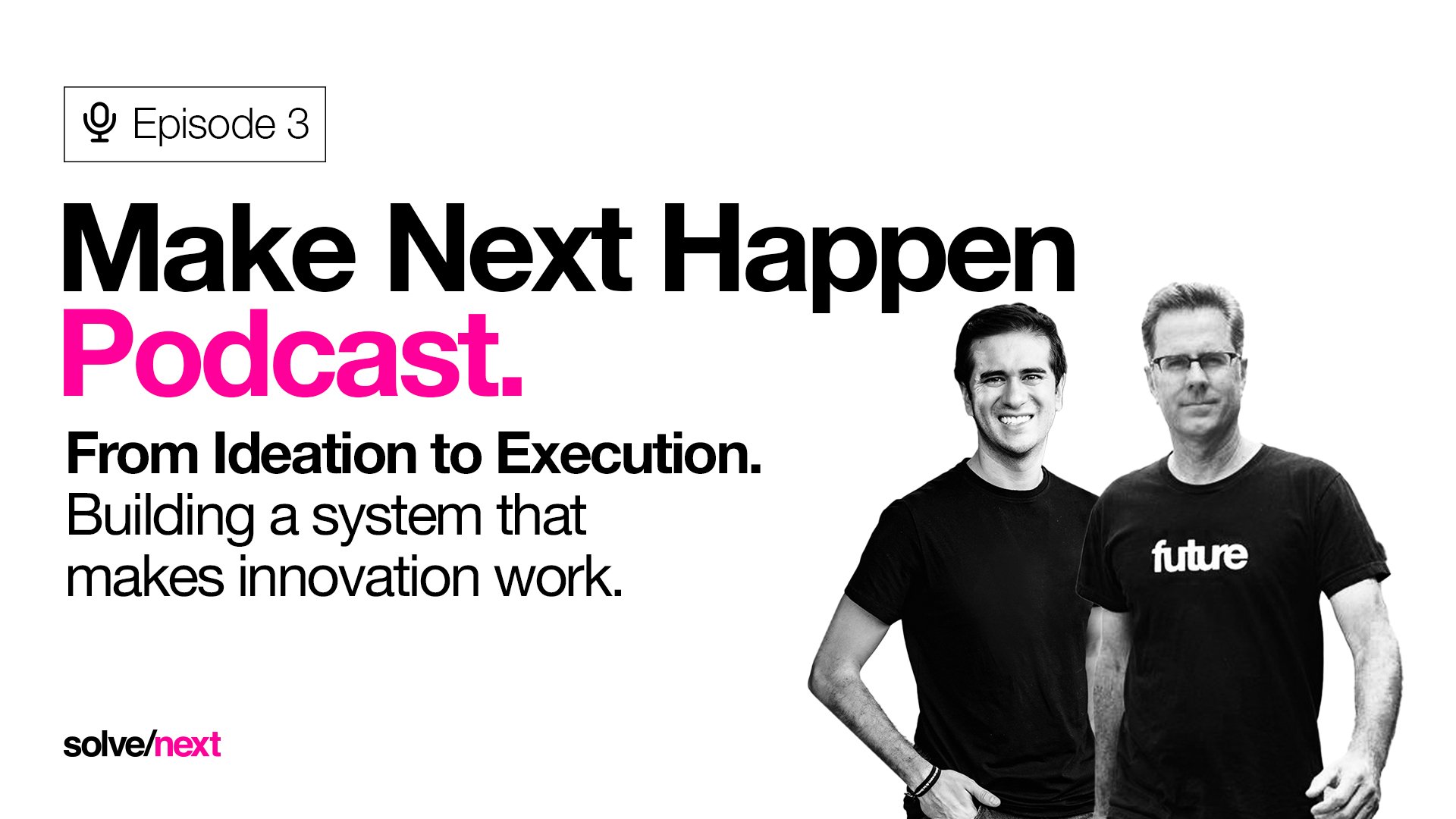Make Next Happen
Podcast.
Ep.3 From Ideation to Execution: Building a system that makes innovation work
Share this Podcast:
In this episode, Greg and Daniel discuss how establishing an innovation culture is fundamentally a response to implementing a systematic innovation framework. They outline how to construct a system that harmonizes performance with innovation, offering essential elements and tactics to manage uncertainty and instigate substantial progress within your organization.
Podcast: Make Next Happen - From Ideation to Execution | Play in new window
(Duration: 22:55 - 33MB)
Subscribe: Apple Podcasts | Spotify | YouTube
Check out the Video Version
From Ideation to Execution: Building a System that Makes Innovation Work
In today’s fast-paced business environment, innovation is a key driver of success. However, many organizations struggle to build a culture of innovation, mistakenly believing it should be the starting point. In our recent podcast episode, we explore the concept of the “Next System”—a framework designed to harmonize performance and innovation systems. Let’s dive into the critical insights and practical steps that can help your organization build a system that makes innovation work, with a focus on the transformative Next Cycle.
The Misconception About Innovation Culture
A common question we encounter is, “How do we build a culture of innovation?” The answer might surprise you: a culture of innovation is not the starting point but the outcome of a well-established system. Think of culture as the end result of various factors, including belief systems, rituals, tools, and processes. If you change one of these factors, the culture shifts. Therefore, to foster a culture of innovation, you need to build a robust innovation system first.
Performance System vs. Innovation System
Most organizations have strong performance systems focused on optimizing efficiency and minimizing risk. These systems are designed to execute known solutions to known problems, emphasizing stability and predictability. On the other hand, an innovation system embraces experimentation, risk, and the unknown. The goal is to transition from the current state “Now” to a future state “Next”, which inherently involves uncertainty and discovery.
Introducing the Next Cycle
The Next Cycle is a proven framework that integrates both performance and innovation systems within organizations, enabling a seamless transition from ideation to execution. This structured approach ensures that innovation is not a sporadic effort but a continuous, repeatable process.
Building an Innovation System with the Next Cycle
To build an effective innovation system using the Next Cycle, consider the following components:
People Layer: Identify the right people with the necessary skills and roles. Ensure you have dedicated innovation roles rather than asking employees to innovate alongside their regular duties. The Next Cycle emphasizes the importance of having a team focused on both current performance and future innovation.
Process Layer: Develop processes and methods for innovation, such as the Next Cycle for moving from ideas to solutions. Establish clear decision-making criteria to guide which projects move forward. The Next Cycle provides a roadmap for navigating the complexities of innovation, from initial idea generation to final execution.
Platform Layer: Create a supportive platform with soft elements like vision, values, and language that promote innovation. Additionally, ensure you have the necessary tools and technology to facilitate the innovation process. The Next Cycle framework includes tools and techniques that help align your organization’s culture and goals with its innovation efforts.
Metrics and Evaluation
Traditional performance metrics like ROI are not suitable for innovation systems. Instead, focus on metrics that measure learning and discovery. Examples include the number of assumptions tested, the outcomes of experiments, and the Learning From Investment (LFI). These metrics help you track progress and make informed decisions about where to allocate resources.
Case Study: Tesla’s Gigafactory
Tesla’s Gigafactory exemplifies the successful integration of performance and innovation systems. Tesla has optimized the production of electric vehicles, making them affordable and efficient. Simultaneously, the company continues to innovate, reducing battery costs and improving production capabilities. This balance between the “Now” and “Next” systems allows Tesla to maintain its competitive edge while driving significant advancements in the industry.
Conclusion
Building a culture of innovation starts with establishing a robust innovation system. By harmonizing your performance and innovation systems using the Next Cycle, you can create an environment where new ideas thrive and drive your organization’s growth. Start by focusing on the people, processes, and platforms that support innovation, and use appropriate metrics to evaluate your progress. With the right system in place, you’ll be well-equipped to turn visionary ideas into capital-building realities.
Ready to start building your innovation system? Learn more about the Next Cycle and how it can transform your approach to innovation by visiting Solve Next. Join us for the next podcast episode, where we’ll dive deeper into practical steps for getting started. Embrace the challenge, and go out and make the next happen!
Meet Greg - He will love to hear from you and share ideas on Serious Capital building, status-quo-busting ideas, and how to make next happen.
Thanks for diving into this game-changing episode with us. We'd love to hear your thoughts and continue this important conversation together. Let’s keep challenging the conventional and redefine value creation in our organizations.
More Resources.
Sponsored by:
“You can’t wait to understand everything to do something. Do one thing, understand one thing, so you can start to understand everything.”
Quote:
Listen via these channels:
Videos
Friday Fireside hosted by Rita McGrath
Listen to Greg Galle and Mike Burn, founders of SolveNext discuss some techniques on how to Think differently of the world especially during the crazy unrealistic circumstances we have been going through.
Next Systems by Greg Galle
Think Wrong
Silicon Valley Design Thinking Club
The Silicon Valley Design Club invited Greg Galle and Mike Burn, who go over how we can Think Wrong to Innovate.
Agitaire, Daniel Hulter and Greg Galle
In this conversation Greg Galle and Daniel Hulter, begin with Greg’s origins in communication design, leading up to Greg’s origins as a design-minded innovator.
Control the Room 2019 + Greg Galle + Think Wrong to Solve Next
Greg Galle is an author, entrepreneur, and instigator. His book Think Wrong: How to Do Work That Matters has become a handbook for people who want to invent what’s next for their organizations, communities, and countries.
Think Wrong to Accelerate your Business Success with Greg Galle and Sean Hyde
Watch Greg Galle, Day 1 Expert Speaker at Small Business Freedom Summit.
Jumping the Ingenuity Gap: Greg Galle at TEDxGrandRapids
Greg Galle, co-founder of Future, a rapid ingenuity firm, wakes up excited by the new possibilities he works to create with his clients—and what those mean for all of us.
Podcasts
Greg Galle, co-found and CEO of Solve/Next, an innovative firm based out of San Francisco and the co-writer of Think Wrong: How to Conquer the Status Quo and Make Work that Matters.
Communicating the Impossible with Think Wrong Author Greg Galle
Mission Forward: Mission to Action
Greg Galle joins Carrie to talk about his book, “Think Wrong,” and all the ways we can use our skills in communications to challenge the self-preserving nature of the cultures we create.
Greg Galle: ‘Being’ In A Different Way
Control The Room
Critical thinking is supposed to be critical, right? Well, not always. Critical thinking sometimes is about how you combine things in new ways and create new things out of them. See what's possible. Not just how you deconstruct them and leave all the parts on the table.”-Gregory Galle









